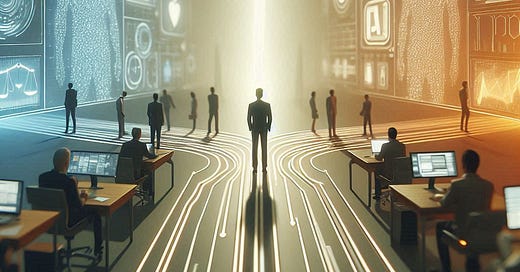Human & Machine: The Minority Report Paradox of Child Protection
A short reflection on AI's predictive power
In Spielberg's dystopian thriller Minority Report, police arrest people for murders they haven't yet committed. Pre-cogs – individuals with supernatural abilities – foresee the crimes, allowing a specialized unit to apprehend perpetrators before they've even conceived their plans. The film explores the deeply problematic nature of a justice system that prosecutes intentions rather than actions. It confronts viewers with an uncomfortable question: is it right to punish someone for a crime they technically never committed?
The rule of law rests on the principle that one is innocent until proven guilty, and that judgment falls on actual deeds, not potential ones. But what many fail to reflect upon is that our child protection system actually operates according to a principle reminiscent of the film's pre-crime department.
Unlike the justice system, which requires evidence beyond reasonable doubt for actions already committed, child protection functions fundamentally differently. Here, future risks are assessed, and interventions occur based on potential harm. As legislation establishes: children's safety must be secured if there exists a significant risk of damage to their health and development.
The ethical dubiousness of the film's concept is evident – but within child protection, this is no dystopian fiction, but a necessary reality. Here, it creates a daily tension for social workers navigating between three competing system logics:
The retrospective, evidence-based logic of the criminal justice system
The forward-looking risk management of child protection
The relationship-oriented work of family support
Herein lies the paradox: we must make decisions about the future based on incomplete information, without either the film's pre-cogs or perfect algorithms. Every decision – to intervene or abstain – carries its own price and its own risks.
With today's AI development, this paradox stands in sharp relief. What if systems could integrate data from schools, healthcare, and social services to identify at-risk children earlier? It could potentially save lives, but also fundamentally alter the balance between human and machine in the welfare state.
Perhaps the greatest challenge in child protection isn't choosing between human judgment and systematization, but configuring systems where both forces collaborate – both pre-cogs and human interpretation in constant dialogue.
A reflection on Social Work






You are always pointing att very important and interesting topics. The perspective here is thoughtful too. The difference here, as I see it, is that we should never claim need of action based on a risk estimation in child protection cases unless we already have harm to a child. The step to hypothesise future risk for the child is, at least to me, a move to engage parents to take steps to make efforts to change.